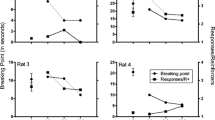Abstract
The effects of imipramine and chlorimipramine on schedule-controlled behavior were compared by examining the effects of both drugs on the performance of pigeons under a multiple fixed-interval 600-s fixed-ratio 30-response (mult FI 600 FR 30) schedule of grain presentation and under a mult FI 200 FI 200 schedule in which responding in one component was punished. Imipramine decreased the rate of FR 30 responding at slightly lower doses than or the same doses as those needed to decrease the rate of FI 600 responding. In contrast, chlorimipramine decreased the rate of FI 600 responding at lower doses than those needed to decrease the rate of FR responding. These effects of chlorimipramine were similar to those of chlorpormazine subsequently determined in the same pigeons. Imipramine and chlorimipramine increased proportionally more or decreased proportionally less the lower rates of responding during the first half of the FI 600 than the higher rates of responding during the second half. When the effects of imipramine or chlorimipramine on performance under the mult FI 200 FI 200 schedule were determined, both imipramine and chlorimipramine affected the rates of punished responding and unpunished responding similarly. Thus, while some effects of chlorimipramine on the schedule-controlled behavior of the pigeon are similar to the effects of imipramine, other effects of chlorimipramine more strongly resemble those of chlorpromazine in the pigeon.
Similar content being viewed by others
References
Azrin NH (1959) A technique for delivering shock to igeons. J Exp Anal Behav 2:161–163
Dews PB (1962) A behavioral output enhancing effect of imipramine in pigeons. Int J Neuropharmacol 1:265–272
Ferster CB, Skinner BF (1957) Schedules of reinforcement. Prentice-Hall, Englewood Cliffs, NJ
Lamb RJ, Chait LD, McMillan DE (1981) The effects of tricyclic antidepressants on responding maintained under a multiple schedule of reinforcement in the pigeon. Fed Proc 40:294
Leander JD (1975) Rate-dependent effects of drugs. II. Effects of some major tranquilizers on multiple fixed-ratio, fixed-interval schedule performance. J Pharmacol Exp Ther 193:689–700
Leander JD, Carter RB (1984) Effects of norepinephrine and serotonin uptake inhibitors on the schedule-controlled behavior of the pigeon. Pharmacol Biochem Behav 29:391–395
Loullis CC, Wayner MJ (1979) Effects of imipramine on schedule-dependent and schedule-induced behavior. Pharmacol Biochem Behav 11:725–728
McGuire PS, Seiden LS (1980a) The effects of tricyclic antidepressants on performance under a differential-reinforcement-of-low-rates schedule in rats. J Pharmacol Exp Ther 214:635–641
McGuire PS, Seiden LS (1980b) Differential effects of imipramine in rats as a function of DRL schedule value. Pharmacol Biochem Behav 13(5):691–694
McKearney JW (1968) The relative effects of d-amphetamine, imipramine and harmaline on tetrabenazine suppression of schedule-controlled behavior in the rat. J Pharmacol Exp Ther 159:429–440
McKearney JW (1982) Effects of tricyclic antidepressant and anticholinergic drugs on fixed-interval responding in the squirrel monkey. J Pharmacol Exp Ther 222:215–219
McMillan DE (1971) Interactions between naloxone and chlorpromazine on behavior under schedule control. Psychopharmacologia 19:128–133
McMillan DE (1973) Drugs and punished responding. I. Ratedependent effects under multiple schedules. J Exp Anal Behav 19:133–145
Morse WH (1964) Effect of amobarbital and chlorpromazine on punished behavior in the pigeon. Psychopharmacologia 6:19–28
O'Donnell JM, Seiden LS (1983) Differential-reinforcement-of-low-rate 72-second schedule: Selective effects of antidepressant drugs. J Pharmacol Exp Ther 224:80–88
Rastogi SK, McMillan DE (1985) Effects of some typical and atypical antidepressants on schedule-controlled responding in rats. Drug Devel Res 5:243–250
Smith CB (1964) Effects of d-amphetamine upon operant behavior of pigeons: Enhancement by reserpine. J Pharmacol Exp Ther 146:167–174
Tseng LF, Harris RA, Loh HH (1978) Blockade of para-methoxyamphetamine-induced serotonergic effects by chlorimipramine. J Pharmacol Exp Ther 204:27–38
Vaillant GE (1967) A comparison of antagonists of physostigmine-induced suppression of behavior. J Pharmacol Exp Ther 157:636–648
Wuttke W, Kelleher RT (1970) Effects of some benzodiazepines on punished and unpunished behavior in the pigeon. J Pharmacol Exp Ther 172:397–405
Zuccarelli RR, Barrett JE (1980) A comparison of the effects of d-amphetamine, cocaine, imipramine, and pentobarbital on local and overall rates of responding maintained under a fourcomponent multiple fixed-interval schedule. Pharmacol Biochem Behav 12:899–907
Author information
Authors and Affiliations
Rights and permissions
About this article
Cite this article
Lamb, R.J., McMillan, D.E. Some effects of chlorimipramine and imipramine on the schedule-controlled behavior of the pigeon. Psychopharmacology 87, 7–11 (1985). https://doi.org/10.1007/BF00431768
Received:
Accepted:
Issue Date:
DOI: https://doi.org/10.1007/BF00431768




